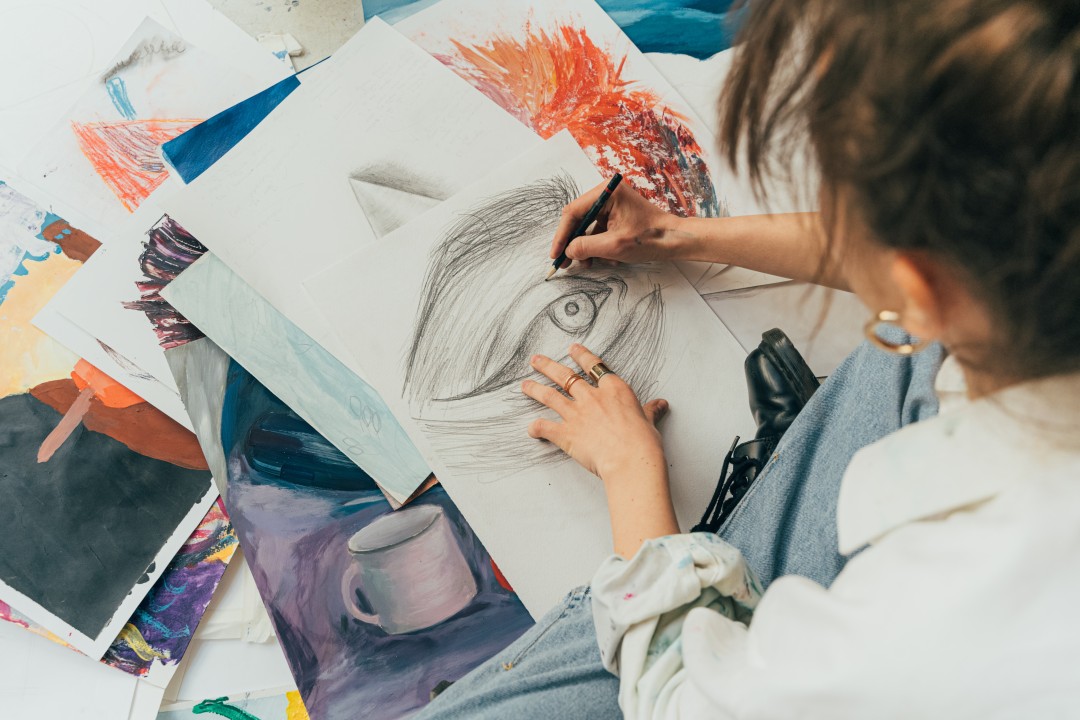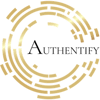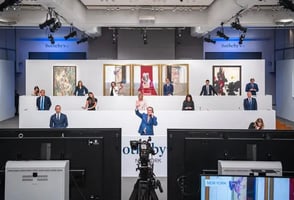Join the Transparency Revolution with Authentify.art
Unveiling the Art Market's Dark Side: An Introduction to Fraud
 Reprinted from LinkedIn, 12 Sept 2023
Reprinted from LinkedIn, 12 Sept 2023
By Mercata Art
Introduction:
Art market fraud refers to deceptive practices and illicit activities within the art industry that aim to deceive buyers, sellers, collectors, and investors. A 2014 report states that over 50% of the art circulating in the market is fake.
Fixing fraud in the art market is crucial for several reasons. Firstly, it helps protect buyers from purchasing counterfeit or misrepresented artworks at inflated prices. By being aware of common fraudulent schemes and tactics used by unscrupulous individuals or organizations, potential buyers can make informed decisions and avoid falling victim to scams.
Secondly, knowledge about art market fraud is essential for artists and legitimate sellers who want to protect their reputations and ensure that their works are not falsely attributed or copied without consent. By staying informed about fraudulent practices in the art market, artists can take necessary precautions to safeguard their creations and intellectual property rights.
Lastly, understanding art market fraud is vital for improving the integrity of the art industry. Fraudulent activities harm individual buyers and undermine trust within the entire marketplace. By actively combating fraud and promoting transparency in transactions, stakeholders in the art world can contribute to a more ethical and trustworthy environment.
Types of Fraud in the Art Market:
In the art market, fraud can take various forms, impacting buyers and sellers. Here are five common types of fraud that occur within the art market:
A. Forgery: This involves creating a fake artwork and attempting to pass it off as an original piece by a renowned artist. Forgers may replicate signatures, styles, and materials to deceive collectors and galleries. For Example: Wolfgang Beltracchi and his wife Helene are a German couple who sold hundreds of forged works by master painters, claiming to have inherited them from Helene's grandfather who fled Germany during World War II. They made an estimated $100 million before being caught when one of their paintings was revealed to be a fake. They were sentenced to prison but served only a short time in an "open prison." Many of the fake pieces are still considered originals and are on display in homes and private collections.
B. Misattribution: Misattribution occurs when an artwork is mistakenly attributed to an artist who did not create it. This can happen due to errors in documentation or intentional misrepresentation by sellers seeking higher valuations. For example: The Salvator Mundi painting by Leonardo da Vinci was long thought to be a copy of the lost original and was worth only £45. However, after its restoration by Dianne Dwyer Modestini, it was confirmed as a work by da Vinci. It was unveiled at an exhibition in London in 2011 and later sold for $127.5 million to a Russian billionaire. In 2017, it was sold again for a record-breaking $450.3 million to a Saudi Arabian prince acting as an intermediary for Crown Prince Mohammed bin. Some even refer to it as the male Mona Lisa given its regained prominence in the art world.
C. Theft: Art theft involves the unlawful taking of artworks from galleries, museums, private collections, or public spaces. Stolen artworks may be resold on the black market or more nefariously reintroduced to the market through private sales. Or present to market as new finds in obscure collections, usually as Artist copies of other works thought to be lost or destroyed. The largest-value art theft occurred at the Isabella Stewart Gardner Museum in Boston, when 13 works, worth a combined $500 million were stolen in 1990. The case remains unsolved.
D. Fraudulent Appraisals: Some individuals manipulate appraisal values to deceive buyers or insurance companies into paying inflated prices for artworks. These fraudulent appraisals misrepresent the true value of the artwork and launder bad works as if they are good. For example: The Getty Museum accepted millions in donated Greek & Roman antiquities between 1973 and 1985 from a network of “wealthy collectors”. Many of these objects were recently excavated & imported into the United States & their value was inflated in forged appraisals. Donors lent their names to the transactions for tax write-offs without ever laying eyes on the said objects. The scheme was discovered by an internal whistleblower, but no one was prosecuted.
E. Money Laundering: Money launderers have exploited the art market, who use high-value artworks to legitimize illicit funds. Criminals can obscure their illegal activities by purchasing expensive artworks through anonymous transactions. For example: a bipartisan Senate investigation in 2020 found that the art world is susceptible to money laundering and sanctions evasion due to inadequate safeguards, such as shell companies with hidden owners and middlemen. The investigation traced more than $18 million in art purchases through auction houses and private dealers back to anonymous shell companies linked to sanctioned Russian oligarchs. The art world is considered to be the largest legal unregulated industry in the United States and is booming, with art sales surpassing $64 billion globally last year.
Collectors, dealers, and institutions involved in the art market must be aware of these types of fraud and take necessary precautions, such as conducting thorough research, verifying provenance and authenticity, seeking expert opinions when needed, and implementing robust security measures to safeguard against fraudulent practices. Art market fraud has increased, fueled by various factors, including online marketplaces, increased globalization, and a lack of regulation and transparency. The United Nations Office on Drugs and Crime (UNODC) has estimated that in 2011, as much as USD 6.3 billion in illicit proceeds could have been laundered through or associated with the trade in cultural objects. These factors have created an environment where fraudulent activities can thrive, leading to significant financial losses for buyers and sellers in the art industry.
How Fraud in the Art Market Has Been Increasing
The Increase in online marketplaces (especially during the pandemic) has provided a platform for fraudulent sellers to operate with relative anonymity. With the ease of creating online profiles and listings, verifying the authenticity of artworks being sold has become increasingly difficult. This has increased cases of fake or counterfeit artworks being passed off as genuine. In 2022 alone Inigo Philbrick, was sentenced to 7 years in prison after pleading guilty to a $86 million fraud, billionaire Michael Steinhardt surrendered 180 looted antiquities worth $70 million & Jean-Luc Martinez- the former director of Louvre, was charged with complicity in an antiquities-trafficking case.
Globalization has also played a role in the increase of art market fraud. As artworks are bought and sold across borders, tracking their provenance and ensuring their authenticity becomes more challenging. The lack of consistent regulations across different countries further complicates matters, making it easier for fraudsters to exploit loopholes in this unregulated market.
The absence of regulations and transparency in some industries, such as financial markets and real estate transactions, enables dishonest individuals to carry out fraudulent activities without facing consequences. Numerous news articles highlight cases where fraudsters receive minimal punishments, such as a mere warning. For instance, the recent case of the Museum Director in Orlando who attempted to pass off fake artifacts as genuine in order to sell them on the market.
To illustrate these issues, numerous high-profile cases of art fraud have come to light in recent years. These cases involve well-known artists' works being forged or misattributed, resulting in substantial financial losses for collectors and investors. These instances serve as cautionary tales highlighting the need for stronger regulation and increased transparency within the art market.
Technology That Protects People Against Fraud in the Art Market
In recent years, the art market has seen an increase in fraudulent activities, making it crucial to implement advanced technologies to protect buyers and sellers from falling victim to scams.
A. Advanced Scientific Authentication Techniques:
have emerged as powerful tools to ensure the authenticity of the artwork. These techniques include forensic analysis, spectroscopy, and radiography, among others. Experts can determine if a piece is genuine or counterfeit by examining materials used in artwork creation and analyzing their properties.
B. Digital Imaging and Analysis:
Digital imaging technology plays a vital role in detecting art forgery by capturing high-resolution images of artworks for detailed analysis. Experts can identify subtle differences between original artworks and their replicas or altered versions through advanced algorithms and image processing techniques.
C. Track and Trace (RFID and GPS):
Radio Frequency Identification (RFID) tags attached to artworks enable tracking throughout their lifecycle. These tags provide real-time data on location, ensuring transparency and preventing theft or substitution of valuable pieces. Global Positioning System (GPS) tracking systems can also be employed for high-value artworks during transportation or while on loan especially for travelling exhibitions.
D. Artificial Intelligence (AI) and Machine Learning:
AI-powered algorithms have revolutionized fraud detection by analyzing vast amounts of data related to art market transactions, artist profiles, provenance records, auction results, etc. Machine learning models can identify patterns indicative of fraudulent activities such as price manipulation or fake provenance documents.
By leveraging these technologies collectively or individually, stakeholders in the art market can significantly reduce the risk of falling prey to fraudsters and organized crime while enhancing trust among buyers and sellers alike.
Note: It is important to remember that while these tech solutions are effective tools against fraud in the art market, human expertise is still an essential component for accurately interpreting results and making informed decisions regarding authenticity.
Blockchain Applications in the Art Market
Blockchain technology has emerged as a promising solution for addressing the challenges of fraud and transparency in the art market. By leveraging its unique characteristics, blockchain offers numerous benefits for art market transactions.
One of the key advantages of blockchain technology in the art market is its ability to provide immutability and transparency. Each transaction on the blockchain is permanent and cannot be altered, ensuring a tamper-proof record of ownership and provenance. This helps to combat future art market fraud by providing a secure and transparent platform for buyers, sellers, and collectors to analyze data.
Smart contracts are self-executing contracts with predefined rules encoded on the blockchain. They automate various aspects of art transactions, such as payment releases upon meeting specific conditions or royalties for artists when their works are resold.
Tokenization simplified and secured fractional ownership of artworks by connecting them to digital tokens on the blockchain, allowing investors to own a portion of an artwork and protects them from the artwork being sold or otherwise diluted without having a specific claim to the art. This is a path to true title for art, protecting buyers, sellers and lenders.
Many companies are working to find ways to successfully take advantage of technology to both combat crime and increase trust and participation. Many of these technologies are excellent and very promising, yet have little to no adoption and are not integrated in the Art Ecosystem. So rather than seeing tech as a solution looking for a problem, MercatArt and Authentify Art worked on solving specific problems in the Art world and saw a way to build an Ecosystem where trust and transparency was its primary mission. Together they bring together advanced technology and anti-fraud tools and make it easy for the Art world to take advantage of these benefits. Their commitment to Veracity of data, transparency and integration with insurance, banking, authentication, logistics, other technology companies and the rest of the art supply chain is what truly sets them apart and appears to provide the most hope for the Art world to finally enter the 21st century in earnest.




